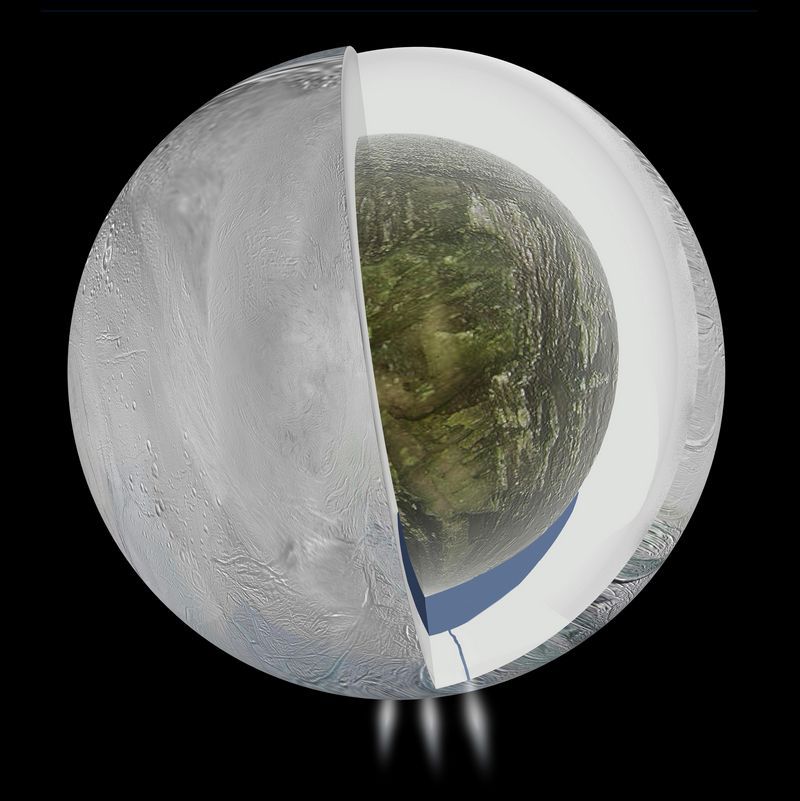Potentially inhabited subglacial ocean found on Enceladus
- Transfer

More and more discoveries lead astronomers to the idea that the far corners of the solar system may be more suitable for life than previously thought. Measurements of the gravitational field of Enceladus, a small satellite of Saturn, confirmed that there is an ocean below the surface of the planet in the southern hemisphere. And astronomers believe that theoretically this ocean can be inhabited.
The presence of an icy ocean on Enceladus was supposed for a long time. Back in 2005, the Cassini apparatus transmitted images showing powerful jets of water vapor emitted by formations called “tiger stripes” located not far from the south pole of an icebound planet. By the way, similar geysers have recently been found in Europe., another ice satellite. By themselves, these geysers do not prove the presence of liquid water under the ice. This may also be due to the emergence of massive tectonic forces created by the gravity of Saturn and leading to displacement of ice masses and the formation of emissions of liquid water.

However, a series of gravitational measurements made by Cassini from 2010 to 2012, astronomers have confirmed the presence of a giant reservoir of liquid water, located below the ice surface on Enceladus. And no less important, the heterogeneity of the structure of the planet itself was confirmed: under the ice there is a rocky core, consisting of silicon compounds. Most surprisingly, a layer of silicates coated with water could form a habitable living environment. Perhaps even more suitable than in Europe.
Gravity anomaly
The geophysical data collected by Cassini showed the presence of an abnormal change in the gravitational field of Enceladus in the region of the south pole. Such negative anomalies occur in areas having a mass below the calculated one. Astronomers deliberately searched for a negative gravitational anomaly in this area, since the planet’s surface was lowered here. But no one expected the anomaly to be so great. It turned out to be significantly larger than was predicted based on surface measurements.

Scientists have suggested that under the surface there should be matter with a higher density. And since water is denser than ice, the only logical explanation was the presence of the subglacial ocean.
South Reservoir
Unlike Europe, with its completely under-ice ocean, Enceladus only has a body of water in the south. It extends up to 50 degrees south latitude, about the middle of the distance to the equator. In the area of the South Pole, the ocean reaches maximum depth.
Enceladus itself is very small, its diameter is only about 500 km. The ocean (by the standards of the earth it is a very large lake) lies 30–40 km long. The thickness of the reservoir reaches 8-10 km. The volume of water is comparable to Lake Superior, the largest of the Great Lakes group.

The fact that liquid water may exist on Enceladus came as a surprise. The surface temperature is about -180 degrees Celsius. Scientists suggest that the source of energy for the formation of such a volume of liquid water is the gravitational field of Saturn. Or it is some kind of own source of energy, the presence of which was not expected on a small ice planet. Europe itself is much larger, almost the size of our moon.
It is still unknown why the ocean is located in the south. It is likely that more intense bending and heating of ice occurs in that area. As for the geysers, perhaps their existence is due to tidal forces, due to which faults have formed in the ice crust.
The Importance of Silicon Compounds for Life
As mentioned, Enceladus has a rocky silicate core with a density of 2.4 g / cm 3 . Silicates are the source of many substances necessary for the existence of life, for example, phosphorus and sulfur compounds. Scientists have already found evidence of the presence of salts and organic molecules in the pair emitted by geysers and around the “tiger stripes”. The combination of water, silicates and an energy source can lead to chemical reactions. In other words, Enceladus is now a promising place for scientists to search for extraterrestrial life.
Potentially habitable zones are found in the solar system in the most unexpected places. For example, Titan, Callisto, and Ganymede may also contain subsurface oceans (so far unconfirmed). Peculiar potentially habitable zonescan also be on gas giants. Although the likelihood of intelligent life on planets so remote from the Sun is extremely low.
Next steps
Now astronomers intend to better study the structure of Enceladus, the exact location, size and shape of the ocean. Gravity field measurements will continue. Future expeditions are supposed to conduct spectrographic studies of geysers to get more information about the composition of water.
